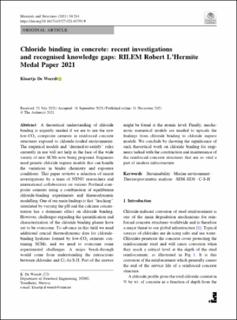| dc.contributor.author | De Weerdt, Klaartje | |
| dc.date.accessioned | 2022-04-12T11:10:45Z | |
| dc.date.available | 2022-04-12T11:10:45Z | |
| dc.date.created | 2021-11-30T23:46:04Z | |
| dc.date.issued | 2021 | |
| dc.identifier.citation | Materials and Structures. 2021, 54 (214), . | en_US |
| dc.identifier.issn | 1359-5997 | |
| dc.identifier.uri | https://hdl.handle.net/11250/2991067 | |
| dc.description.abstract | A theoretical understanding of chloride binding is urgently needed if we are to use the new low-CO2 composite cements in reinforced concrete structures exposed to chloride-loaded environments. The empirical models and “deemed-to-satisfy” rules currently in use will not help in the face of the wide variety of new SCMs now being proposed. Engineers need generic chloride ingress models that can handle the variations in binder chemistry and exposure conditions. This paper reviews a selection of recent investigations by a team of NTNU researchers and international collaborators on various Portland composite cements using a combination of equilibrium chloride-binding experiments and thermodynamic modelling. One of our main findings is that “leaching” simulated by varying the pH and the calcium concentration has a dominant effect on chloride binding. However, challenges regarding the quantification and characterization of the chloride binding phases have yet to be overcome. To advance in this field we need additional crucial thermodynamic data for chloride-binding hydrates formed by low-CO2 cements containing SCMs, and we need to overcome some experimental challenges. A major break-through would come from understanding the interactions between chlorides and C(-A)-S-H. Part of the answer might be found at the atomic level. Finally, mechanistic numerical models are needed to upscale the findings from chloride binding to chloride ingress models. We conclude by showing the significance of such theoretical work on chloride binding for engineers tasked with the construction and maintenance of the reinforced concrete structures that are so vital a part of modern infrastructure. | en_US |
| dc.language.iso | eng | en_US |
| dc.publisher | Springer | en_US |
| dc.rights | Navngivelse 4.0 Internasjonal | * |
| dc.rights.uri | http://creativecommons.org/licenses/by/4.0/deed.no | * |
| dc.title | Chloride binding in concrete: recent investigations and recognised knowledge gaps: RILEM Robert L’Hermite Medal Paper 2021 | en_US |
| dc.type | Journal article | en_US |
| dc.type | Peer reviewed | en_US |
| dc.description.version | publishedVersion | en_US |
| dc.source.pagenumber | 16 | en_US |
| dc.source.volume | 54 | en_US |
| dc.source.journal | Materials and Structures | en_US |
| dc.source.issue | 214 | en_US |
| dc.identifier.doi | 10.1617/s11527-021-01793-9 | |
| dc.identifier.cristin | 1962312 | |
| cristin.ispublished | true | |
| cristin.fulltext | preprint | |
| cristin.fulltext | preprint | |
| cristin.fulltext | postprint | |
| cristin.fulltext | original | |
| cristin.qualitycode | 1 | |

